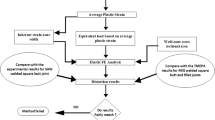Abstract
For a welding procedure with grooves or filler materials, to avoid underestimating the welding distortion in predictions based on the residual plastic strain, a prediction approach is proposed to estimate the welding distortion based on the local displacement in the weld plastic zone, and the proposed method is verified using the thermal elastic–plastic finite element method. Additionally, the welding distortions of an orthotropic deck are estimated using the proposed method and compared with the experimental measurements. The results show that the proposed method can be used to predict the welding distortion with a high accuracy, and in addition to the welding procedures with grooves or filler materials, the proposed method is also applicable to procedures without them.














Similar content being viewed by others
References
Ueda Y, Yamakawa T (1971) Analysis of thermal elastic-plastic stress and strain during welding by finite element method. Trans Japan Welding Soc 2(2):90–100
Wang J, Ueda Y, Murakawa H, Yang HQ, Yuan MG (1996) Improvement in numerical accuracy and stability of 3-D FEM analysis in welding. Weld J 75(4):129–134
Michaleris P, Zhang L, Bhide SR, Marugabandhu P (2006) Evaluation of 2D, 3D and applied plastic strain methods for predicting buckling welding distortion and residual stress. Sci Technol Weld Join 11(6):707–716. doi:10.1179/174329306x147724
Ueda Y, Yuan MG, Ueda Y, Yuan MG (2003) Numerical simulation of residual stress and deformation considering phase transformation effects. Trans JWRI 32(2):325–333
Ueda Y, Fukuda K, Nakacho K, Endo S (1975) A new measuring method of residual stresses with the aid of finite element method and reliability of estimated values. Trans JWRI 4(2):123–131
Michaleris P, DeBiccari A (1997) Prediction of welding distortion. Weld J 76(4):172–181
Zhang L, Michaleris P, Marugabandhu P (2006) Evaluation of applied plastic strain methods for welding distortion prediction. J Manuf Sci Eng 129(6):1000–1010
Tsirkas SA, Papanikos P, Pericleous K, Strusevich N, Boitout F, Bergheau JM (2003) Evaluation of distortions in laser welded shipbuilding parts using local-global finite element approach. Sci Technol Weld Join 8(2):79–88. doi:10.1179/136217103225010899
Deng D, Ma N, Murakawa H (2011) Finite element analysis of welding distortion in a large thin-plate panel structure. Trans JWRI
Deng D, Murakawa H, Ma N (2012) Predicting welding deformation in thin plate panel structure by means of inherent strain and interface element. Sci Technol Weld Join 17(1):13–21. doi:10.1179/1362171811y.0000000065
Ueda Y, Fukuda K (1989) New measuring method of three-dimensional residual stresses in long welded joints using inherent strains as parameters—Lz method. J Eng Mater Technol 1:1–8
Liang W, Deng D, Sone S, Murakawa H (2005) Prediction of welding distortion by elastic finite element analysis using inherent deformation estimated through inverse analysis. Weld World 49(11–12):30–39
Liang W, Murakawa H (2012) An inverse analysis method to estimate inherent deformations in thin plate welded joints. Mater Des 40(1):190–198
Wang JH, Lu H (2002) Some discussions on principle of causing and relieving welding residual stress. Trans China Weld Inst 23(3):75–79
SYS WORLD (2011) Sysweld reference manual. ESI China, Shanghai, China
Goldak J, Chakravarti A, Bibby M (1984) A new finite element model for welding heat sources. Metall Trans B 15(2):299–305
Brickstad B, Josefson BL (1998) A parametric study of residual stresses in multi-pass butt-welded stainless steel pipes. Int J Pres Ves Pip 75(1):11–25
Smith M, Bouchard P, Turski M (2012) Accurate prediction of residual stress in stainless steel welds. Comput Mater Sci:312–328
Acknowledgements
This work was financially supported by the National Natural Science Foundation of China (Grant No. 51378430).
Author information
Authors and Affiliations
Corresponding author
Additional information
Recommended for publication by Commission X - Structural Performances of Welded Joints - Fracture Avoidance
Rights and permissions
About this article
Cite this article
Gu, Y., Li, Y.D., Qiang, B. et al. Welding distortion prediction based on local displacement in the weld plastic zone. Weld World 61, 333–340 (2017). https://doi.org/10.1007/s40194-016-0418-5
Received:
Accepted:
Published:
Issue Date:
DOI: https://doi.org/10.1007/s40194-016-0418-5




